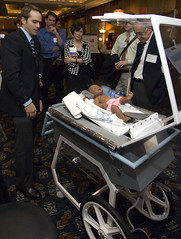
We're back everyone. After a long stretch of work that included some exciting and blog worthy moments, I've finally caught up with my RSS reader and Blogger to bring you more consistent posts.

We have been simply too busy to blog, which is a shame, because it's been the "good busy" type of busy. We've been awash with devices and great people who are more interested than ever in the convergence of medical technology and international development. That means more LTDC posts than ever in the coming weeks. While this is certainly not an IIH blog, I might as well explain what IIH (and by extension myself) have been up to.

Last week,
CIMIT held their annual Innovation Congress which featured an
Exploratorium which prominently featured global health medical technologies by the
CIMIT Global Health Initiative spearheaded by
Dr. Kris Olson and his crack team of innovation specialists [shown at left demonstrating their car parts incubator], as well as IIH technologies (thanks CIMIT!) working under the same tent (or thatch roof...)
We pulled allnighters trying to get newer prototypes delivered, last minute machining, and 3 am diagnostic reactions to make a good showing at the event. By listening to the crowd, it seems our team achieved that.

The week before CIMIT, we were invited to participate in the last session of MIT's Center for Biomedical Innovation's
"Critical Elements of a "Learning Healthcare System" workshop, which featured a poster session on global health. We saw our friends at
X Prize,
M-Lab (MIT's Mobility Lab which designs mobility solutions for the developing world), the
BAMM lab's CD4 microfluidic technology, and the other IIH,
Innovators in Health which invented the uBox and uPhone telemedical systems for tuberculosis compliance.


Throughout this time, we were delivered the news that Interamerican Bank for Development is going to support us to bolster our collaboration with our Nicaraguan partners,
CIES (Centro de Investigaciones y Estudios de la Salud) and CARE Nicaragua. The support will accelerate our collaboration with this dynamic organizational duo by deploying a set of field ready biomedical learning kits that will allow Nicaraguan innovators to come up with their own medical technology innovations. Check out the Scidev scoop
here.
Beyond all this, we owe you updates on Joost Bonsen's Development Ventures and their great line up of startups to tackle the Millenium Challenges, my field notes from the upcoming Duke conference on Bioengineering Global Health, and another round of devices from the CIMIT event.







